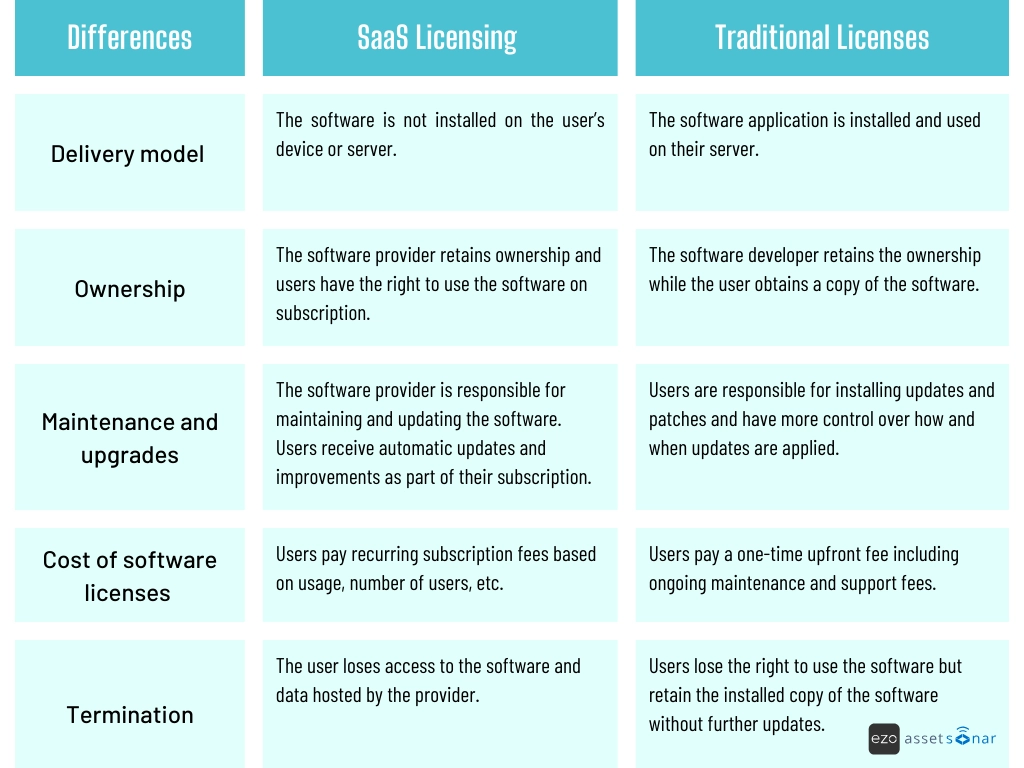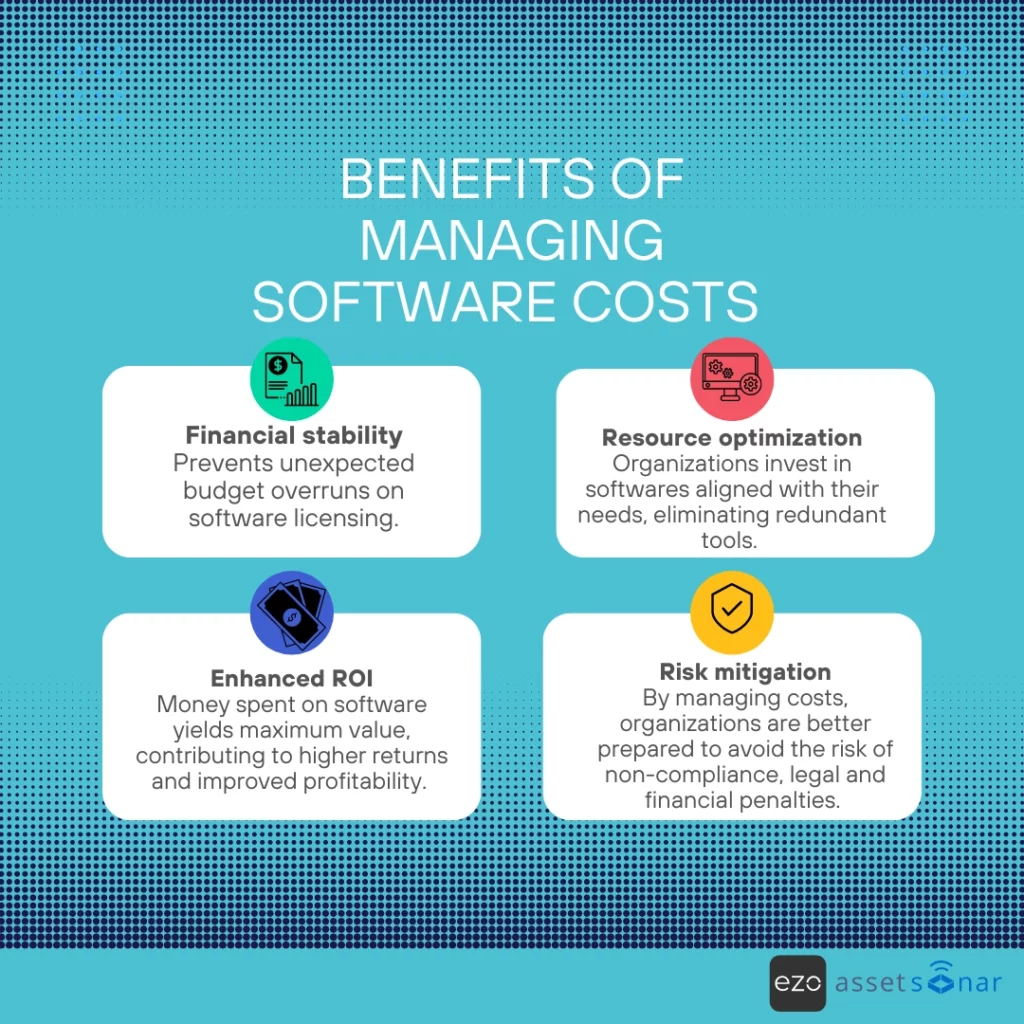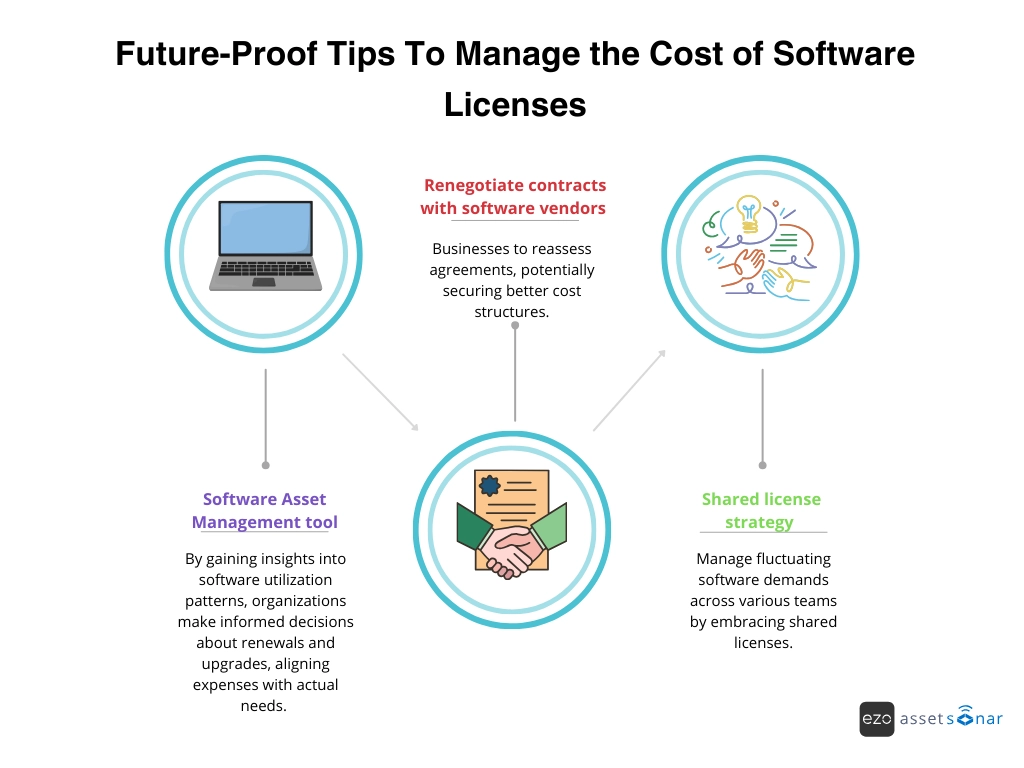Suppose M&R Tech Solutions spent $600,000 on software licenses to run their project management operations smoothly. A year later, the cost of renewing software licenses had increased to $650,000. An unexpected 10% increase in the cost of software licenses exceeded the budget allocated, leading to a budget shortfall, higher expenses, and a decrease in net profit by $50,000.
M&R Tech decided to reduce these costs by reducing the number of licenses or using unlicensed softwares. Doing so exposed them to significant risk of non-compliance with software license agreements and potential legal ramifications. According to the ITAM review:

Is your organization in the same boat as M&R Tech Solutions due to the rise in software license costs? Is your organization facing the risk of SaaS license waste? In this blog, you can learn how to mitigate these challenges, factors influencing licensing costs, strategies to manage software licenses, and stay updated on future trends to sustain organizational growth and competitiveness in the industry.
Track license costs
What are Software Licenses?
Any organization acquiring and installing software has legally entered into an agreement with the software provider known as a software license. Also known as an end-user license agreement (EULA), it outlines and establishes rules, requirements, and restrictions on how the licensee uses the software, how usage costs are determined, and how much the licensee can copy, modify, or distribute the software.
The license is also designed to protect the intellectual property of software providers and limit any claims that may arise from using the software.

5 main software license types
Users can opt for different software licenses based on their business needs, the number of user arrangements, and the level of restrictions the licensor imposes. Five main software license categories include a wide spectrum of licensing, from public domain to proprietary software.
- Public domain licenses: A free-to-use license that users can modify without restrictions, for example, SQLite, I2P, and CERN.
- Lesser general public licenses(LGPL): Software developers can link to open-source libraries within their software. The code can be licensed under any other license type linked to include an LGPL-licensed library. Adobe Acrobat uses the iText library, which is licensed under the LGPL.
- Permissive: One of the common and popular open-source licenses that imposes few restrictions on software modifications, such as the Apache license.
- Copyleft: This license is reusable and modifiable without restrictions, only the modified code released shall follow the same license code and restrictions as the original one. This means the modified code must carry the same restriction if the original code was specified as ‘personal use only.’ Examples include the Linux kernel and MySQL database.
- Proprietary: The most restrictive type of license that doesn’t allow copying, modifying, or distribution of the software. Microsoft Windows code isn’t accessible to users for changes, protecting the owner from unauthorized use of the software.
Software license cost models
The level of restrictiveness increases from lesser general public licenses to proprietary licenses, enticing users’ decision to buy and impacting the cost of software licenses. As technology evolves, various software license cost models are introduced, giving users and vendors more control over the product and its cost. Ultimately, these models cater to user demands, protect intellectual property, and maximize returns to the cost of developing software licenses. Here are a few licensing model types:
- Subscription Licensing Model
Users pay a recurring fee to access the software for a fixed term, monthly or annually. Along with software licenses, users enjoy regular updates, patches, and ongoing support as subscribers.
- Device licensing model
Software is installed onto the required number of devices for end-users. The licenses are purchased according to a certain number of devices, where software may be uninstalled on one and installed on another within the same organization. To avoid penalties, the IT admin ensures the total number of installations does not exceed the number of purchased licenses.
- Consumption/Usage-Based Licensing model
The cost of software licenses depends upon usage factors, including time, frequency of use, storage volumes, or product-specific features. The licenses are purchased in advance per estimated use and are subsequently deducted with each use.
- Feature Licensing model
Feature licensing models are priced based on how product configurations are customized for different users. Vendors provide entry-level functionality at a basic cost which can be upgraded to access more valuable features. IT admins can control access to ensure other users can access features suited to their roles.
From a software vendor’s point of view, software monetization is a crucial process that determines the overall cost of software licenses. Based on cost and value, they offer different licensing cost models to monetize software development costs and maximize returns.
Software monetization is a process of generating revenue from licensing, distribution, and services provided for a software product. The aim is to maximize the return from sales and rentals of software applications, gain other profits by delivering value-added services, and prevent unauthorized software usage to avoid revenue leakage.

5. Concurrent Licensing model
Among the most flexible licensing models, the concurrent licensing model gives users a defined number of licenses to be used concurrently and on any device. It is a cost-effective model for organizations where users work across multiple time zones and concurrent licenses can be shared among users having different working hours.
6. SaaS Licensing model
Users access software in the cloud under SaaS licensing rather than downloading a copy of the software application. It is licensed on a subscription basis and is popular because users avoid the upfront costs of purchasing and maintaining software and infrastructure. The license fee is paid regularly, and SaaS providers handle access, updates, and maintenance. The differences between SaaS licensing and traditional software licenses are as follows:

Why is software licensing important?
Do you know organizations that install unlicensed software have nearly one in three chances of malware attacks? In software piracy cases, the original or copyright owner can make your organization liable for using the software and be obligated to pay damages in case of legal claims. Software licensing protects organizations from such cybersecurity threats, lawsuits, and losses. According to the BSA Global Software Survey:

It is also important that software licenses are used per their specified conditions. Multiple users utilizing single-user licenses risk having their licenses revoked and accounts deactivated. It is prohibited to redistribute or over-utilize software licenses.
Purchasing several software licenses, each with a single-user license is a possible but pricey solution. Instead, a feasible licensing option would be volume licensing. Large school districts requiring multiple product licenses but not multiple copies of the software can opt for volume licensing at a discounted cost. The same applies to students in colleges and universities where single-user licenses cannot be used across a whole course or year group, while volume licensing would work best in these cases.
7 factors influencing the cost of software licenses
It is critical to understand the factors impacting the costs of software licenses in this intricate licensing landscape. It helps software developers, organizations, and business owners who want to license intellectual property better comprehend the subtleties of licensing costs. For example, Adobe Creative Cloud offers subscription-based licensing that allows users to access various powerful tools. The cost calculation is based on features, usage, and user type (individual, business, or educational) offered.
- Scope of use: The cost increases or decreases if extensive rights are granted or vice versa. A personal use license has narrowly defined rights and would cost less than a business software license which extensively grants rights and costs higher.
- Duration: Short-term licenses for specific projects cost less than perpetual licenses.
- Software license maintenance: Ongoing support and updates are additional costs of software licenses.
- Market demand and supply: If demand for particular software licenses exceeds supply, licensing costs will rise. Conversely, oversupply can decrease the costs of software licenses. The costs for cutting-edge technologies like AI algorithms and blockchain technology are steep due to high demand.
- Geographic regions and markets: Software license costs for niche markets such as specialized medical tracking software can be extremely high.
- Negotiation skills with vendors: Large organizations with significant bargaining power can negotiate better terms than SMBs
- Industry-specific factors: Healthcare and pharmaceutical industries require complex negotiations with regulatory bodies, which can impact software costs. IT and tech focus on holistic factors such as user base, features, and scalability.
- Cost vs budget: Software license costs can be calculated based on the users entitled to use the software. The average cost per entitled software would be:
Average Cost per Entitled Software = Total Cost of Entitled Software per Member/No. of Entitlements
If the average cost per user exceeds the budget, corrective measures must be taken to reduce the cost.

Want to know your license costs?
Strategies for Managing Software License Costs
- Need analysis and evaluate software usage
Conducting thorough analysis helps understand required software usage, discover unnecessary costs, and take corrective actions to reduce software license costs.
The first step is gathering software usage information such as user profiles and counts, activity and feedback. Let’s say the finance department is looking to install management software. They can begin with
- User profile and count: Estimate the number of employees in the department and calculate user count based on how many users would have access to software licenses. Financial analysts, account executives, and managers can better manage accounts than trainees and interns.
- User activity and feedback: Finance employees are involved in bookkeeping, managing credits, and maintaining quarterly and yearly accounts. Next, feedback should be taken from personnel involved in these activities. Manually tracking high-volume invoices can be challenging therefore they can provide feedback to implement robust and confidential management software to track, generate reports, and maintain privacy accurately.
The next step is to look through the software licenses and agreements database to identify duplicate ones and eliminate redundant agreements. Once evaluated, these licenses can be replaced with a single licensing solution. For example, if three departments use three different software applications for note-taking purposes, only one can be kept, and the other two can be revoked.
- Negotiate better terms with vendors
Organizations must use their best negotiation skills to secure advantageous licensing agreement terms with vendors. The length of the contract and the number of users are two main factors to negotiate to reduce the costs of software licenses. A licensing agreement for a longer term can negotiate contract restructuring in terms of adjusting or discounting payment terms or imposing price caps to protect your budget.
- Reduction in other costs
Software costs include other costs like maintenance, warranty, and support fees. You can negotiate discounted support costs when renewing subscriptions or ask to suspend these costs for shelfware software, paying for software actively used for operations, and optimizing the software budget. According to TechRepublic report:

- Scalability with software asset management tool
A robust and feature-rich software asset management (SAM) solution can help track and manage licenses efficiently and optimize software spend. Insightful metrics and in-depth reports provide active, underutilized, duplicate, or overutilized license details, enabling organizations to make informed decisions.
Map your license utilization to costs in minutes. Download our guide now
What can go wrong with installing or using software licenses?
From end user:
1. They can install software on work laptops without an appropriate license.
2. They might purchase software subscriptions without informing the relevant department or breach the terms of purchasing licenses, such as payment via personal credit card without authorization.
3. They buy legitimate software but from unauthorized sites.
From IT Department:
1. They can redeploy existing software without checking license entitlements.
2. Configuration of hardware, software, and environment might breach license terms.
3. The IT Department licenses software incorrectly by:
- Utilizing licenses outside their terms and conditions, for example, using academic licenses in a commercial environment.
- Using the wrong software versions, for example, the Professional version rather than the Standard.
- Wrong or no communication of terms and conditions to end users after installing a new license.
- Failure to remove software after contract terms have ended.
From Supplier/Vendor:
1. They ship hardware with inappropriate OEM software
2. They sell unauthorized or pirated software.
The misuse of software licenses can lead to severe impacts. A few of them are:
- Legal Consequences: Ignorance or breach of licensing terms may result in fines, penalties, or lawsuits from software vendors.
- Financial Loss: IT admins unaware of license entitlements might lead to over or under-purchasing licenses. Over Licensing can tie up capital in unused licenses, while under licensing may result in fines or an immediate need to purchase additional licenses at a premium.
- Security Risks: Using unlicensed software or improperly using license terms may expose systems to security vulnerabilities. Lacking crucial updates and patches can leave the system vulnerable to malicious attacks.
- Reputation damage: If news spreads that your organization is violating license terms, it can impact your relationships with customers, partners, and investors.

How IBM manages software licenses cost
IBM uses diverse licensing models specific to its products to meet varied client needs. It can be based on the number of processor value units, resources, virtual environments, or capacity on demand per business requirements. Next, they consult IBM license metric tools to estimate cost based on usage. After choosing the best-fit license model, its terms and agreements are thoroughly reviewed, and inventory is updated and aligned with current usage, preventing over- and under-licensing. Regular compliance audits are performed to identify areas to optimize the cost of software licenses and avoid unnecessary expenses.
Future Trends and Considerations
Staying ahead or in line with future trends can better adapt to changing costs, allocate resources within budget, and gain a competitive advantage. Here are a few trends to look at:
- Cloud-based licensing: License models tailored to cloud deployment are gaining traction. SaaS technology has opened new revenue streams, such as pay-as-you-go or usage-based pricing, attracting users to opt for these cost-effective alternatives. This is why the ability to securely store and manage licenses in the cloud and transition from application to the cloud would be beneficial in the long term.
- Industrial Digital Transformation: Using the software is indispensable for controlling critical functions like collecting and analyzing data. However, it is most vulnerable to malicious attacks, code cloning, tampering, and counterfeiting. Industrial transformation shall include software developed with stronger protocols and improvise secure, resilient, and trustworthy strategies.
- Smart contracts and online licensing: Digitization has enabled licensors and licensees to more effectively manage and track licensing agreements, cost payments, and contract negotiations. A secure and transparent exchange of licensing terms and conditions provides tamper-proof records of all transactions. Online licensing platforms and management systems enable streamlined stakeholder communication, real-time data sharing, and enhanced transparency.

In a dynamic technology-intensive ecosystem, understanding and managing the cost of software licenses effectively is paramount because of its direct impact on an organization’s bottom line and operational efficiency. With the evolving landscape of software licensing impacted by subscription-based models, cloud services, and open-source alternatives, organizations shall navigate a complex terrain to optimize software spending and maximize ROI.
Frequently asked questions for software licenses
What factors influence the cost of software licenses?
The cost of software licenses depends on usage factors, including time, frequency of use, storage volumes, or product-specific features.
What are the hidden costs associated with software licenses?
Beyond the initial purchase price, hidden costs can include implementation, customization, training, maintenance, support, and potential hardware upgrades.
How can organizations reduce or manage software license costs?
Organizations can reduce costs by:
- Conducting regular software audits to eliminate unused licenses.
- Negotiating volume or enterprise agreements.
- Using Software Asset Management (SAM) tools to optimize license allocation.
- Avoiding over-purchasing through accurate forecasting.
Leveraging open source or alternative software where appropriate.
What is the difference in cost between open-source and proprietary software licenses?
Open-source software is generally free to use but may incur costs related to implementation, customization, and support. Proprietary software typically requires purchasing licenses, which can be more expensive but often come with dedicated support and regular updates.
How do software vendors determine pricing for their licenses?
Vendors often use data-driven approaches to set pricing, considering factors like customer usage patterns, market demand, and value delivered. This helps in aligning pricing with perceived value and optimizing revenue.
What are the cost implications of scaling software usage in an organization?
As organizations grow, scaling software usage can lead to increased licensing costs, especially if additional user licenses or features are required. It’s essential to assess scalability and associated costs when selecting software solutions.
Are there cost benefits to using cloud-based or SaaS applications?
Cloud-based and SaaS applications often offer flexible pricing models, allowing organizations to pay based on usage. This can lead to cost savings, especially for businesses with fluctuating needs.
How can organizations manage software license renewals to control costs?
Implementing a centralized license management system can help track renewal dates, avoid unnecessary renewals, and negotiate better terms, thereby controlling costs.
What role does software asset management play in controlling licensing costs?
Effective software asset management ensures optimal utilization of licenses, compliance with licensing agreements, and identification of cost-saving opportunities through better visibility and control over software assets.
What are the legal and financial consequences of non-compliance with software license agreements?
Non-compliance can result in audits, hefty fines, forced license purchases, legal action, and reputational damage, which can be costly and disruptive.
What is software monetization and how does it impact license pricing?
Software monetization refers to strategies vendors use to maximize revenue from software, including licensing models, pricing tiers, and feature bundling. It influences how licenses are priced and sold, affecting overall cost.
What are the latest trends in software licensing and cost management?
Trends include increased adoption of subscription and usage-based models, automation of license management through SAM tools, integration with cloud platforms, focus on compliance and security, and emphasis on cost optimization through analytics.







